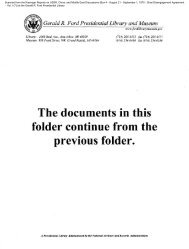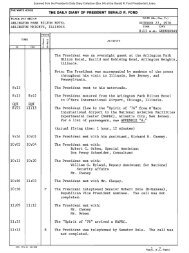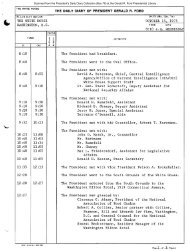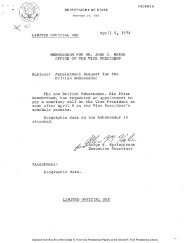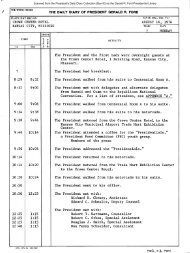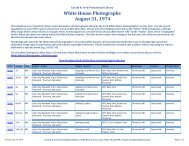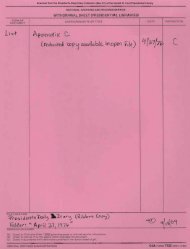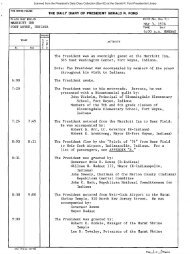October 31, 1975 - Gerald R. Ford Presidential Library and Museum
October 31, 1975 - Gerald R. Ford Presidential Library and Museum
October 31, 1975 - Gerald R. Ford Presidential Library and Museum
Create successful ePaper yourself
Turn your PDF publications into a flip-book with our unique Google optimized e-Paper software.
incorporated in computerized auditing procedures to identify incorrect<br />
units of information <strong>and</strong> operators were telephoned to obtain consistent<br />
data.<br />
Misinterpretation of instructions or definitions which were not<br />
flagged by the screen could distort estimates. In the case of natural<br />
gas estimates be1n9 reported in thous<strong>and</strong>s instead of millions of cubic<br />
feet, the estimate would tend to be overstated.<br />
Field Identification <strong>and</strong> Delineation<br />
To compare operator responses to a known base, FEA obtained 1973<br />
crude oil <strong>and</strong> gas production by fields from all States in which this<br />
information was available. However, in many instances, validation<br />
<strong>and</strong> delineation of fields to compare State production, operator production,<br />
field study production, decline curve production, <strong>and</strong> the 100<br />
oil fields <strong>and</strong> 50 gas fields for which the API <strong>and</strong> AGA published<br />
reserve estimates required data tabulations by h<strong>and</strong>. This resulted<br />
from inexact labeling of data entries into the benchmark system,<br />
inexact labeling of field names provided by operators, <strong>and</strong> grouping of<br />
previously individually designated <strong>and</strong> named fields into areas, trends,<br />
<strong>and</strong> other fields.<br />
Throuqh the use of auxiliary information purchased for 15 principal<br />
oil <strong>and</strong> gas producing States including operator production by field <strong>and</strong><br />
State allowable schedules, the FEA was able to identify satisfactorily<br />
<strong>and</strong> delineate virtually all fields for which API, AGA, <strong>and</strong> FEA field<br />
studies reserve data were available.<br />
The expansion of reserves for those responses that did not provide<br />
the data at a field level by using the ratio of reserve to production<br />
would have provided a more precise estimate than the State level expansion<br />
<strong>and</strong> the application of theoretical decline curves to calculate<br />
reserves. However, the delineation problems mentioned would have<br />
greatly increased the time <strong>and</strong> manpower requirements.<br />
Manpower Constraints<br />
There were insufficient technically qualified personnel available<br />
within FEA to complete the study in the allotted time. A total of 25<br />
professionals from three offices of the USBM, one office of<br />
Energy Research Development Administration <strong>and</strong> two FEA Offices assisted<br />
in the processing, analyzing <strong>and</strong> obtaining of additional information<br />
from operators. The work of these professionals contributed significantly<br />
to improvements in data quality. A sufficient number of<br />
personnel were made available to process, edit, encode, keypunch, <strong>and</strong><br />
verify data submissions; develop computerized systems; <strong>and</strong> process the<br />
data. At peak periods in April <strong>and</strong> May between 65 <strong>and</strong> 70 persons worked<br />
on the operator survey portion of this project.<br />
54



